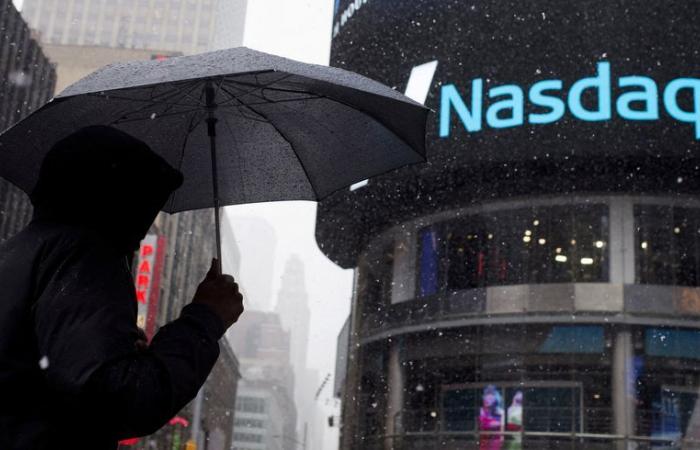Mike Dolan provides an update on the US and global markets for the day ahead.
The dollar continues to feed on speculation over post-election tariffs and tax cuts, China’s fight against deflation and Germany’s brewing political crisis, while the euro hits its highs the lowest in almost five months.
Although bond markets remained closed Monday due to the Veteran’s Day holiday, the dollar built on last week’s election-related rally, spurred by Friday’s news, later denied by other sources. , according to which protectionist Robert Lighthizer had already been tipped to become President-elect Donald Trump’s new trade official.
During Mr. Trump’s first term, Mr. Lighthizer played a key role in imposing tariffs on Chinese imports and in renegotiating the North American Free Trade Agreement with Mexico and the Canada.
With final results awaited in the House of Representatives elections, but with Republicans widely expected to wipe out the White House and Congress, attention is now shifting to the names of members of the Trump team being formed.
Ironically, while speculation over Trump’s tariffs is seen as a positive for the dollar, Lighthizer is also seen as a big advocate of a weaker dollar to help trade competitiveness and reports earlier in the year indicated that he and others were looking for ways to devalue the currency.
Yet with only vague ideas about how this might be achieved, the market seems content with a straight reading of the tariffs, and the dollar index rose on Monday, within a whisker of four-month highs in last week.
Famed investor Scott Bessent met with Donald Trump on Friday, as he and fellow investor John Paulson emerge as the leading contenders for the key Treasury secretary post.
The euro and Chinese yuan were the two main currencies to fall against the dollar, as the latter was hit by a new wave of investor disappointment over Beijing’s debt-increasing recovery plans on Friday. , then by the worrying news concerning inflation at the end of the week.
China’s consumer prices rose at the slowest pace in four months in October, at an annual rate of just 0.3%, while producer price deflation deepened to 2.9%. over the past year.
Offset by fears over U.S. tariffs, markets were rattled by the latest stimulus measures from the country’s top legislature, which on Friday approved a 10 trillion yuan ($1.4 trillion) package aimed at to alleviate the burden of “hidden debt” on local governments.
However, new bank loans in China fell more than expected in October from the previous month and remained below analysts’ expectations as the latest round of stimulus measures failed to boost credit demand.
Hong Kong’s benchmark Hang Seng Index fell more than 1% on Monday to its lowest level since Oct. 18, although mainland stocks posted a modest gain.
GERMAN GOVERNMENT CRISIS
The euro was the other mover, driven by fears of universal tariffs and the backlash of any direct hit to Chinese demand, as well as the German political crisis which could lead to early elections at the start of the new year.
German Chancellor Olaf Scholz and Mr Trump spoke on Sunday evening to exchange views on bilateral relations and geopolitical challenges, but Mr Scholz had more pressing issues to address and said he would be willing to host a vote of confidence in parliament before Christmas.
That timeline is earlier than the January date he proposed last week, suggesting the March timeline for the election could also be moved forward.
Given the combination of US and Chinese risks to the European economy since Trump’s victory last week, Deutsche Bank has reduced its forecast for the European Central Bank’s “terminal” interest rate in this cycle. half a point at 1.5%.
European stocks, meanwhile, rose about 1% on Monday.
On Wall Street, the “Trump transactions” continue. Bitcoin hit an all-time high of over $81,000 on Monday as the crypto industry is expected to boom amid a favorable regulatory environment under the Trump administration and crypto-friendly candidates be elected to Congress.
And U.S. stock futures continued to advance ahead of today’s open after the S&P500 on Friday topped $6,000 for the first time in its history.
In addition to attention on the new political team in Washington, markets this week will focus on October’s consumer price and retail sales reports, as well as the end of another earnings season. companies that promise to be excellent.
While the Federal Reserve delivered another quarter-point interest rate cut, as expected, last week, it remains unclear how much Trump’s tariffs and tax cuts will worsen the inflation situation in the future. Only three more quarter-point rate cuts are now fully planned by the end of next year, 100 basis points less than the Fed itself indicated in September.
Key developments expected to provide more direction to U.S. markets later on Monday:
*The Veterans Day holiday closes U.S. federal offices and the bond market. Stock markets remain open.
* Mexico: industrial production in September, consumer confidence in October
* Results of American companies: Live Nation Entertainment






